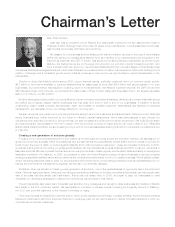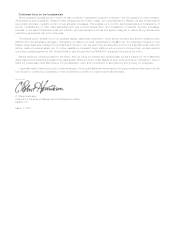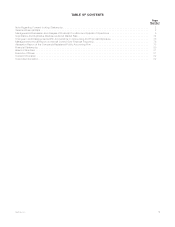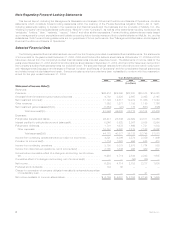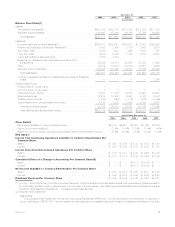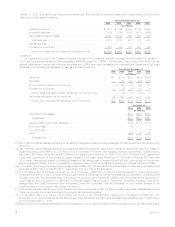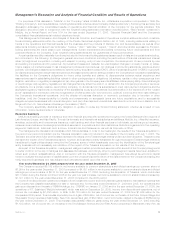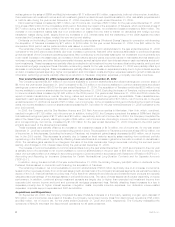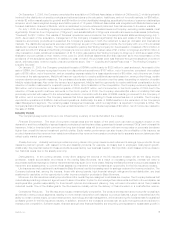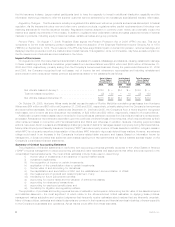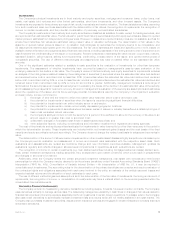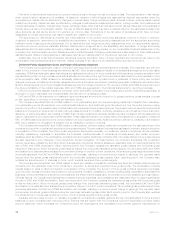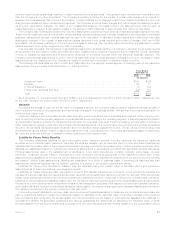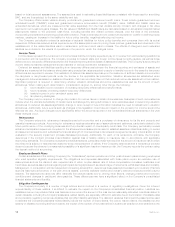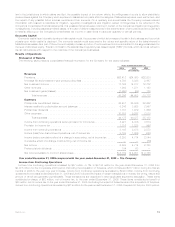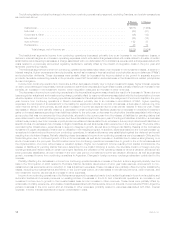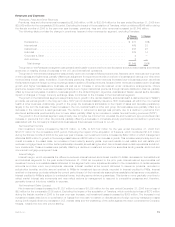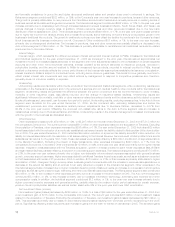MetLife 2006 Annual Report Download - page 12
Download and view the complete annual report
Please find page 12 of the 2006 MetLife annual report below. You can navigate through the pages in the report by either clicking on the pages listed below, or by using the keyword search tool below to find specific information within the annual report.Investments
The Company’s principal investments are in fixed maturity and equity securities, mortgage and consumer loans, policy loans, real
estate, real estate joint ventures and other limited partnerships, short-term investments, and other invested assets. The Company’s
investments are exposed to three primary sources of risk: credit, interest rate and market valuation. The financial statement risks, stemming
from such investment risks, are those associated with the determination of fair values, the recognition of impairments, the recognition of
income on certain investments, and the potential consolidation of previously unconsolidated subsidiaries.
The Company’s investments in fixed maturity and equity securities are classified as available-for-sale, except for trading securities, and
are reported at their estimated fair value. The fair values for public fixed maturity securities and public equity securities are based on quoted
market prices or estimates from independent pricing services. However, in cases where quoted market prices are not available, such as for
private fixed maturities, fair values are estimated using present value or valuation techniques. The determination of fair values in the
absence of quoted market prices is based on: (i) valuation methodologies; (ii) securities the Company deems to be comparable; and
(iii) assumptions deemed appropriate given the circumstances. The fair value estimates are made at a specific point in time, based on
available market information and judgments about financial instruments, including estimates of the timing and amounts of expected future
cash flows and the credit standing of the issuer or counterparty. Factors considered in estimating fair value include: coupon rate, maturity,
estimated duration, call provisions, sinking fund requirements, credit rating, industry sector of the issuer, and quoted market prices of
comparable securities. The use of different methodologies and assumptions may have a material effect on the estimated fair value
amounts.
One of the significant estimates related to available-for-sale securities is the evaluation of investments for other-than-temporary
impairments. The assessment of whether impairments have occurred is based on management’s case-by-case evaluation of the
underlying reasons for the decline in fair value. The Company’s review of its fixed maturity and equity securities for impairments includes
an analysis of the total gross unrealized losses by three categories of securities: (i) securities where the estimated fair value had declined
and remained below cost or amortized cost by less than 20%; (ii) securities where the estimated fair value had declined and remained
below cost or amortized cost by 20% or more for less than six months; and (iii) securities where the estimated fair value had declined and
remained below cost or amortized cost by 20% or more for six months or greater. Additionally, management considers a wide range of
factors about the security issuer and uses its best judgment in evaluating the cause of the decline in the estimated fair value of the security
and in assessing the prospects for near-term recovery. Inherent in management’s evaluation of the security are assumptions and estimates
about the operations of the issuer and its future earnings potential. Considerations used by the Company in the impairment evaluation
process include, but are not limited to:
i) the length of time and the extent to which the market value has been below cost or amortized cost;
ii) the potential for impairments of securities when the issuer is experiencing significant financial difficulties;
iii) the potential for impairments in an entire industry sector or sub-sector;
iv) the potential for impairments in certain economically depressed geographic locations;
v) the potential for impairments of securities where the issuer, series of issuers or industry has suffered a catastrophic type of
loss or has exhausted natural resources;
vi) the Company’s ability and intent to hold the security for a period of time sufficient to allow for the recovery of its value to an
amount equal to or greater than cost or amortized cost;
vii) unfavorable changes in forecasted cash flows on asset-backed securities; and
viii) other subjective factors, including concentrations and information obtained from regulators and rating agencies.
The cost of fixed maturity and equity securities is adjusted for impairments in value deemed to be other-than-temporary in the period in
which the determination is made. These impairments are included within net investment gains (losses) and the cost basis of the fixed
maturity and equity securities is reduced accordingly. The Company does not change the revised cost basis for subsequent recoveries in
value.
The determination of the amount of allowances and impairments on other invested asset classes is highly subjective and is based upon
the Company’s periodic evaluation and assessment of known and inherent risks associated with the respective asset class. Such
evaluations and assessments are revised as conditions change and new information becomes available. Management updates its
evaluations regularly and reflects changes in allowances and impairments in operations as such evaluations are revised.
The recognition of income on certain investments (e.g. loan-backed securities including mortgage-backed and asset-backed secu-
rities, certain investment transactions, trading securities, etc.) is dependent upon market conditions, which could result in prepayments
and changes in amounts to be earned.
Additionally, when the Company enters into certain structured investment transactions, real estate joint ventures and other limited
partnerships for which the Company may be deemed to be the primary beneficiary under Financial Accounting Standards Board (“FASB”)
Interpretation (“FIN”) No. 46(r), Consolidation of Variable Interest Entities — An Interpretation of ARB No. 51, it may be required to
consolidate such investments. The accounting rules for the determination of the primary beneficiary are complex and require evaluation of
the contractual rights and obligations associated with each party involved in the entity, an estimate of the entity’s expected losses and
expected residual returns and the allocation of such estimates to each party.
The use of different methodologies and assumptions as to the determination of the fair value of investments, the timing and amount of
impairments, the recognition of income, or consolidation of investments may have a material effect on the amounts presented within the
consolidated financial statements.
Derivative Financial Instruments
The Company enters into freestanding derivative transactions including swaps, forwards, futures and option contracts. The Company
uses derivatives primarily to manage various risks. The risks being managed are variability in cash flows or changes in fair values related to
financial instruments and currency exposure associated with net investments in certain foreign operations. To a lesser extent, the Company
also uses credit derivatives to synthetically replicate investment risks and returns which are not readily available in the cash market. The
Company also purchases investment securities, issues certain insurance policies and engages in certain reinsurance contracts that have
embedded derivatives.
9MetLife, Inc.


